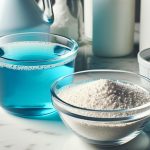Borax is a powerful natural agent that neutralizes odors in fabrics, making it essential for your laundry routine. It works by breaking down odor-causing substances and enhancing your detergent’s cleaning power. Adding borax helps tackle tough odors, like sweat and mildew, while also softening water for better cleaning. It’s non-toxic and eco-friendly, providing effective deodorization without harmful residues. Discover how to maximize its benefits for stain removal and fabric care.
Table of Contents
Key Takeaways
- Borax neutralizes acids and bases, effectively breaking down odor-causing substances in fabrics for enhanced deodorization during washing.
- It serves as a laundry booster, improving detergent efficacy and fabric penetration for better odor removal.
- Borax can be used as a stain remover when mixed with water, addressing odor sources rather than just masking them.
- Pre-soaking garments in a borax solution helps eliminate tough sweat and mildew odors from fabrics.
- Being eco-friendly and non-toxic, borax provides a safer alternative to harsh chemical deodorizers for fabric cleaning.
What Is Borax and How Does It Work?
Although you might be familiar with borax as a household cleaner, it’s also an effective fabric deodorizer. Borax, or sodium borate, is a naturally occurring mineral that helps eliminate odors by neutralizing acids and bases.
When you add borax to your laundry, it works by breaking down odor-causing substances, making them easier to wash away. This mineral enhances the cleaning power of detergents, allowing them to penetrate fabrics more effectively.
Additionally, borax can help soften water, which further boosts its deodorizing capabilities. Whether you’re dealing with gym clothes or musty towels, incorporating borax into your laundry routine can leave your fabrics smelling fresh and clean.
The History of Borax in Cleaning
You might be surprised to learn that borax has roots in ancient cleaning traditions, where it was prized for its natural cleansing properties.
During the Industrial Revolution, its popularity skyrocketed, transforming how people approached cleaning.
Today, borax remains a staple, finding new applications in modern households.
Ancient Cleaning Traditions
As people sought effective ways to maintain cleanliness throughout history, borax emerged as an essential ingredient in ancient cleaning traditions. This natural mineral has been used for centuries, valued for its remarkable cleaning properties. You’ll find borax in ancient Egyptian households, where it was utilized to wash linens and preserve the freshness of fabrics.
| Civilization | Use of Borax | Cleaning Methods |
|---|---|---|
| Ancient Egypt | Washing linens | Boiling and soaking |
| Ancient Rome | Stain removal | Mixing with oils |
| Chinese Dynasties | Fabric deodorizing | Infusing in water |
These early practices highlight borax’s role in effective cleaning, setting the stage for its continued use in modern fabric care.
Industrial Revolution Impact
With the onset of the Industrial Revolution, the demand for effective and efficient cleaning agents surged, leading to a significant evolution in the use of borax.
Factories and urban households faced new challenges from increased pollution and dirt. People began to recognize borax as a versatile cleaner, capable of tackling tough stains and odors.
As industrial processes improved, borax production ramped up, making it more accessible for everyday use. You might find it in laundry products, household cleaners, and even in early formulations for deodorizing fabrics.
This period marked a shift, where borax changed from a niche mineral to a household staple, forever altering how you approach cleaning and deodorizing fabrics in your home.
Modern-Day Applications
Although borax has a long history in cleaning, its modern-day applications showcase its continued relevance and versatility.
You might be surprised to learn how useful this natural mineral is in your everyday life. Here are a few ways you can incorporate borax into your routine:
- Laundry Booster: Add it to your washing machine to enhance detergent performance and deodorize fabrics.
- Stain Remover: Create a paste with water to tackle tough stains on clothing or upholstery.
- Household Cleaner: Mix it with water for a powerful all-purpose cleaner that cuts through grime.
Benefits of Using Borax for Fabric Deodorizing
When you’re looking to freshen up your fabrics, using borax can be a game changer. This natural mineral effectively neutralizes odors, making your clothes, towels, and linens smell clean and fresh.
Unlike some synthetic deodorizers, borax doesn’t just mask smells; it tackles the source of the odor, ensuring a deeper clean. It’s also versatile—use it in laundry or as a pre-soak for tougher fabrics.
Plus, borax is non-toxic and eco-friendly, giving you peace of mind while you deodorize. You’ll appreciate the added benefits of stain removal and fabric brightening, making your items look as good as they smell.
Comparing Borax to Other Fabric Deodorizers
While many fabric deodorizers promise fresh-smelling results, comparing borax to these alternatives reveals distinct advantages.
Borax stands out for its natural properties and effectiveness in neutralizing odors without relying on harsh chemicals. Here’s how it stacks up against other popular options:
Borax excels in natural odor neutralization, offering a chemical-free alternative to many commercial deodorizers.
- Natural vs. Synthetic: Unlike many sprays that contain artificial fragrances, borax offers a more natural approach.
- Odor Neutralization: Borax doesn’t just mask odors; it eliminates them, making it more effective than many commercial products.
- Versatility: It’s not just for deodorizing; borax can help with cleaning and stain removal, unlike some deodorizers that serve only one purpose.
When looking for a dependable fabric deodorizer, borax proves to be a smart choice over many alternatives.
How to Use Borax in Your Laundry Routine
To make your laundry routine more effective, incorporating borax can elevate your washing process considerably.
Start by adding half a cup of borax to your washing machine along with your regular detergent. This boosts the cleaning power while neutralizing odors. For best results, use it in warm or hot water, as borax dissolves more effectively at higher temperatures.
If you’re washing heavily soiled items, pre-soak them in a solution of borax and water to lift stubborn stains and smells. Don’t forget to check the care labels on your fabrics to verify compatibility.
With consistent use, you’ll notice fresher, cleaner laundry that smells great. Embrace borax as a simple, effective addition to your laundry routine!
Tips for Treating Specific Odors With Borax
When it comes to tackling tough odors, borax is a powerful ally in your laundry arsenal.
If you’re dealing with sweat odors, a simple borax soak can work wonders.
For mildew smells, borax can help eliminate the source and leave your fabrics smelling fresh again.
Sweat Odor Treatment
Sweat odors can be stubborn, but using borax can effectively neutralize them. To tackle those persistent smells in your clothes, follow these simple tips:
- Pre-soak: Mix half a cup of borax with warm water and soak your sweaty garments for about 30 minutes before washing.
- Add to laundry: Toss in half a cup of borax with your regular detergent during the wash cycle to boost odor-fighting power.
- Spot treatment: Create a paste with borax and water, apply it directly to the affected areas, and let it sit for 15-20 minutes before washing.
Mildew Odor Removal
If you’ve ever opened a laundry basket to find clothes that smell musty, you’re not alone. Mildew odors can be stubborn, but borax is here to help.
Start by adding half a cup of borax to your washing machine along with your regular detergent. This powerful mineral works to neutralize the odor and kill mildew spores.
For particularly smelly items, consider soaking them in a solution of borax and water for about 30 minutes before washing. You can also sprinkle borax on affected fabrics, let it sit for a few hours, and then vacuum it off.
Don’t forget to dry your clothes thoroughly, as moisture can lead to mildew returning. With these tips, you’ll have fresh-smelling fabrics in no time!
Borax and Stain Removal: A Powerful Duo
Although many people associate Borax with laundry freshness, it’s equally effective for tackling tough stains. When you’re dealing with spills or marks on your favorite garments, Borax can be your go-to solution.
Here’s how to use it effectively:
- Pre-treat Stains: Mix Borax with water to create a paste, apply it directly to the stain, and let it sit for about 30 minutes.
- Boost Your Laundry: Add half a cup of Borax to your regular detergent to enhance its stain-fighting power.
- Clean Your Surfaces: Use Borax on upholstery or carpets to lift out stains while deodorizing at the same time.
With these tips, you’ll find Borax is an indispensable ally in your stain removal arsenal!
Safety Considerations When Using Borax
When using borax, you need to be aware of potential risks to your skin and lungs.
Make sure to take proper precautions to avoid irritation and inhalation hazards.
Additionally, storing borax safely is essential to prevent any accidental exposure.
Skin Irritation Risks
While borax is often praised for its effectiveness in deodorizing fabrics, it’s essential to be aware of potential skin irritation risks associated with its use. Many people may experience reactions when coming into direct contact with borax, so it’s important to take precautions.
Here are a few tips to help you minimize the risk:
- Wear gloves: Protect your hands from direct contact with borax to prevent irritation.
- Rinse thoroughly: After washing fabrics, make sure to rinse them well to remove any borax residue.
- Test first: If you’re unsure how your skin will react, conduct a patch test on a small area before using it extensively.
Inhalation Safety Precautions
Using borax for fabric deodorizing can also pose risks through inhalation, especially in powder form. To minimize these risks, take some essential safety precautions. Always use borax in well-ventilated areas and consider wearing a mask to avoid inhaling fine particles.
Here’s a quick reference table for inhalation safety precautions:
| Precaution | Description | Importance |
|---|---|---|
| Ventilation | Guarantee good airflow during use | Reduces inhalation risk |
| Mask Usage | Wear a dust mask when handling powder | Protects respiratory health |
| Avoid Mixing | Don’t mix with other chemicals | Prevents harmful reactions |
| Clean Up | Immediately clean spills | Prevents dust accumulation |
Proper Storage Guidelines
To guarantee the safe use of borax, it’s crucial to follow proper storage guidelines. Keeping borax properly stored not only protects you but also assures it remains effective for your fabric deodorizing needs.
Here are some key tips to keep in mind:
- Seal it tightly: Always store borax in a tightly sealed container to prevent moisture and contamination.
- Keep it out of reach: Store borax in a high cabinet or a locked space, especially if you have children or pets around.
- Avoid heat and humidity: Place the container in a cool, dry area, away from direct sunlight and heat sources to maintain its potency.
Eco-Friendly Aspects of Borax
Borax, a natural mineral, offers an eco-friendly solution for fabric deodorizing. When you choose Borax, you’re opting for a biodegradable product that won’t harm the environment.
Unlike many synthetic detergents, Borax breaks down easily, ensuring it doesn’t linger in waterways or soil. You can feel good about using it, knowing it’s derived from the earth and doesn’t contribute to harmful chemical pollution.
Additionally, using Borax helps reduce your reliance on harsh chemicals often found in commercial fabric deodorizers. It’s effective in neutralizing odors without leaving behind toxic residues.
Common Misconceptions About Borax in Laundry Care
While many people praise Borax for its cleaning power, several misconceptions linger about its use in laundry care. You might think Borax is a harsh chemical, but that’s not true—it’s a natural mineral!
Borax is often misunderstood; it’s not a harsh chemical but a natural mineral that boosts your laundry cleaning power!
Here are some common myths you should know about:
- It’s toxic: Borax is safe when used correctly. Just avoid ingesting it and keep it out of reach of children and pets.
- It’s only for whites: Borax can brighten colors too. It works well with both whites and colored fabrics.
- It replaces detergent: Borax enhances your detergent’s effectiveness but shouldn’t be used as a complete substitute.
Understanding these misconceptions will help you use Borax effectively in your laundry routine!
Frequently Asked Questions
Can Borax Be Used on All Fabric Types?
You shouldn’t use borax on all fabric types. It’s safe for whites and colorfast fabrics, but it can damage delicate materials like silk or wool. Always check care labels before using any cleaning agents.
How Long Should I Soak Fabrics in Borax Solution?
You might be wondering how long to soak your fabrics in a borax solution. Generally, it’s best to soak them for 30 minutes to an hour, but always check for specific fabric care instructions first.
Is Borax Safe for Washing Machine Use?
Yes, borax is safe for washing machines when used correctly. It helps boost detergent effectiveness and can tackle tough stains. Just remember to follow the recommended amounts to avoid residue buildup and guarantee peak performance.
Can Borax Eliminate Pet Odors From Fabrics?
Yes, borax can help eliminate pet odors from fabrics. When you add it to your laundry, it neutralizes odors and boosts your detergent’s effectiveness, leaving your fabrics smelling fresher and cleaner after washing.
Will Borax Affect the Color of My Clothes?
You might wonder if borax can fade your clothes. It generally won’t affect colors when used properly. Always test on a hidden area first to be safe, ensuring your fabrics stay vibrant and intact.
- The Use of Nonwovens in Construction and Civil Engineering - July 11, 2025
- The Use of Nonwovens in Construction and Civil Engineering - July 11, 2025
- The Use of Nonwovens in Construction and Civil Engineering - July 11, 2025







